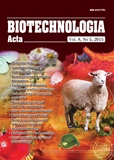ISSN 2410-7751 (Print)
ISSN 2410-776X (Online)

"Biotechnologia Acta" V. 8, No 5, 2015
https://doi.org/10.15407/biotech8.05.071
Р. 71-77, Bibliography 20, English
Universal Decimal Classification: 504.53.054 – 032.32 + 581.1: 604.2: 661.185
A. R. Banya 1, O. Y. Karpenko 3, V. I. Lubenets 3, V. I. Baranov 2,
V. P. Novikov 3, O. V. Karpenko 1
1 Department of Physical Chemistry of Fossil Fuels of L.M. Litvinenko Institute of Physical-Organic and Coal Chemistry of the National Academy of Sciences of Ukraine, Lviv
2 Ivan Franko Lviv National University, Ukraine
3 Lviv Polytechnic National University, Ukraine
The aim of the work was to study the influence of rhamnolipid biocomplex and ethylthiosulfanilate on field pea and sorghum plants when growing in petroleum contaminated soil. Plant seeds were treated with solutions of rhamnolipid biocomplex or ethylthiosulfanilate (0.01 g/l) before planting and grown in containers with soil artificially contaminated with petroleum (5, 8 and 10%). Effect of rhamnolipid biocomplex and ethylthiosulfanilate was determined by the determination of growth (weight, length plants) and biochemical parameters (content of photosynthetic pigments, hydrogen peroxide, malondialdehyde).
The stimulating effect of rhamnolipid biocomplex and ethylthiosulfanilate on growth parameters of field pea was shown: the shoot mass has significantly increased on 39%, root mass – on 26% if compared with the control. For sorghum somewhat smaller increase of growth parameters was observed. Under the influence of rhamnolipid biocomplex and ethylthiosulfanilate the content of photosynthetic pigments in field pea and sorghum has also increased. It was determined that the action rhamnolipid biocomplex and ethylthiosulfanilate promoted the decrease of indicators of plant oxidative reactions if compared with control: the content of hydrogen peroxide – in average on 15% and 16%, malondialdehyde – on 13.5% and 16% respectively.
The results of the study testify to the effectiveness of rhamnolipid biocomplex and ethylthiosulfanilate as growth stimulators for field pea and sorghum, as well as improvement of adaptive capability of plants to unfavorable conditions. It creates the prospects of their application as effective and ecologically safe substances for the intensification of contaminated soil phytoremediation.
Keywords: rhamnolipid biocomplex, ethylthiosulfanilate, field pea, sorghum, petroleum.
© Palladin Institute of Biochemistry of the National Academy of Sciences of Ukraine, 2015
References
1. Telysheva G., Jashina L., Lebedeva G., Dizhbite T., Solodovnik V. Use of plants to remediate soil polluted with oil. Environ. Technol. 2011, V. 1, P. 38–45.
2. Baranov V., Rahmetov D., Gavrylyak M. The effect of new regulators of growth on growth and phisiological indexis of seedlings tiphon on extracts from terricons soil of coal mining. Visn. Lviv. un-tu. Biology series. 2010, 52, P. 191–198. (In Ukrainian).
3. Bulak P., Walkiewicz A., Brzezinska M. Plant growth regulators-assisted phytoextraction. Biologia plantarum. 2014, 58 (1), P. 1–8.
http://dx.doi.org/10.1007/s10535-013-0382-5
4. Terek O., Velychko O., Yavorska N. The mechanisms of adaptation of the soya sproutlets in condition of stress under emistym C and agrostimulin influence. Visn. Lviv. un-tu. Biology series. 2006, 41, P. 132–136. ( In Ukrainian).
5. Pacwa-P?ociniczak M., P?aza G. A., Piotrowska-Seget Z., Cameotra S. S. Environmental applications of biosurfactants: recent advances. Int. J. Mol. Sci. 2011, V. 12, P. 633–654.
http://dx.doi.org/10.3390/ijms12010633
6. Karpenko O. V., Korecka N. I., Shheglova N. S., Karpenko I. V., Baranov V. I. Gramineae plants growth stimulation by surface-active rhamnolipids. Biotechnol. acta. 2013, 6 (6), P. 94–99. (In Ukrainian). doi:10.15407/biotech6.06.094
7. Rita de Cassia F. S. Silva, Darne G. Almeida, Raquel D. Rufino, Juliana M. Luna, Valdemir A. Santos, Leonie Asfora Sarubbo. Applications of biosurfactants in the petroleum industry and the remediation of oil spills. Int. J. Mol. Sci. 2014, V. 15, P. 12523–12542.
8. Ilarionov S. A., Nazarov A. V., Kalachnikova I. G. The role of micromycetes in phytotoxicity contaminated soils. Ekologiya. 2003, V. 5, P. 341–346. (In Russian).
9. Lubenec V. I. Thiosulphonic acid derivatives : synthesis and properties. Ukr. Khim. zh. 2003, 69 (3), P. 109–117. (In Ukrainian).
10. Lubenets V., Vasylyuk S., Baranovych D., Komarovska-Porokhnyavec O., Rayevska K., Zaichenko O., Novikov V. The plant protection remedies of thiosulfonate type. Chem. Agricult. Environ. 2007, V. 8, P. 163–167.
11. Martynova N., Lyholat Yu. The activity of antioxidant protection components in ground cover plants in the technogenic pollution conditions are given. Visn. Kyiv. un-tu. Introdukciia ta zberezhennia roslynnoho riznomanittia. 2009, 25–27, P. 107–108. (In Ukrainian).
12. Lushchak V. I., Bagnjukova T. V., Luzhna L. I. Indices of oxidative stress. 2. Lipid peroxides. Ukr. Biokhim. Zhurnal. 2006, 78 (5), P. 113–119. (In Ukrainian).
13. Karpenko Ye. V., Pokinbroda T. Ya., Makitra R. G., Palchikova Ye. Ya. Optimal methods of isolation of biogenic rhamnolipid surfactants. Zh. obshchey khimii. 2009, V. 12, P. 2011. (In Russian).
14. DSTU 4138-2002. Seeds crops. Methods for determining the quality Effective as. 2004-01-01. Kyiv: Derzhspozhyvstandart Ukrainy. 2003, P. 173.
15. Musiienko M., Parshykova T., Slavnyj P. Spectrographic methods in practical physiology, biochemistry and ecology of plants. Kyiv: Fitosociocentr. 2001, P. 200. (In Ukrainian).
16. Bagnyukova T. V., Lushchak O. V., Storey K. B., Lushchak V. I. Oxidative stress and antioxidant defense responses by goldfish tissues to acute change of temperature from 3 to 23 °C. J. Therm. Biol. 2007, V. 32, P. 227–234.
http://dx.doi.org/10.1016/j.jtherbio.2007.01.004
17. Li-Men Chen, Ching-Huei Kao. Effect of excess copper on rice leaves: evidence for involvement of lipid peroxidation. Bot. Bull. Acad. Sin. 1999, V. 40, P. 283–287.
18. Sandstrom R. P., Cleland R. E. Selective delipidation of the plasma membrane by surfactants enrichment of sterols and activation of ATPase. Plant Physiol. 1989, 90 (4), P. 1524–1531.
http://dx.doi.org/10.1104/pp.90.4.1524
19. Golovko T. K., Dalkie I. V., Zahozhyj I. G., Dymova O. V., Tabalenkova G. N. Functional plasticity and stability of the photosynthetic apparatus to photoinhibition Plantago media. Zh. Fiziol. rasteniy. 2011, 58 (4), P. 490–501. (In Russian).
20. Ashraf M., Harris P. J. C. Photosynthesis under stressful environments. An overview. Photosynthetica. 2013, V. 51, P. 163–190.
http://dx.doi.org/10.1007/s11099-013-0021-6

